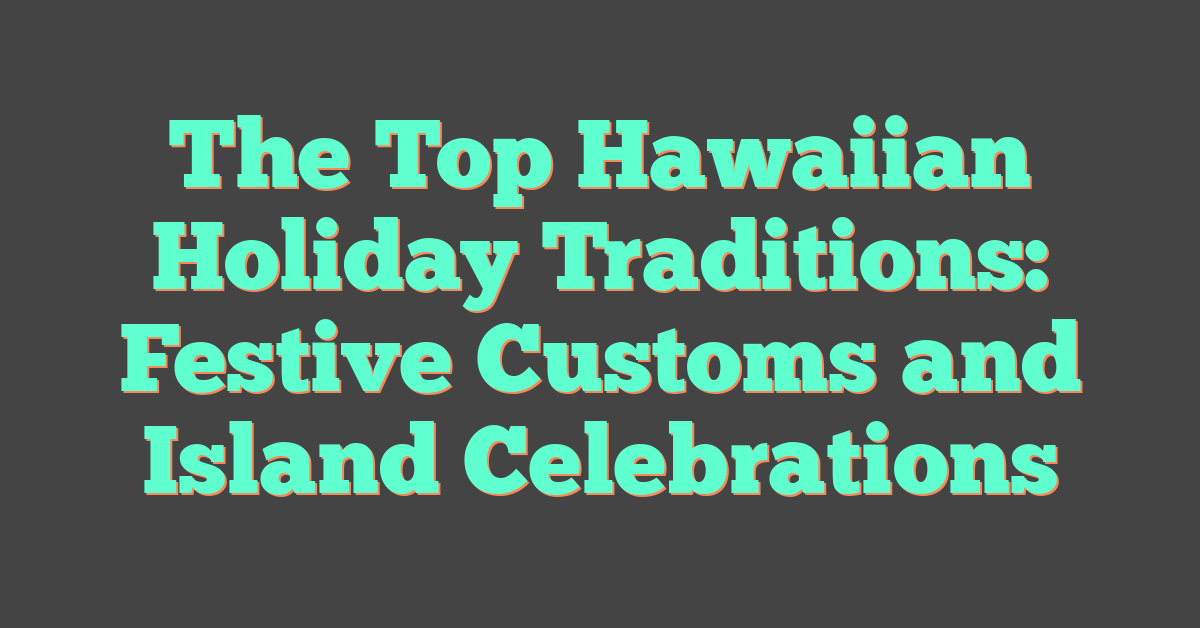When I think about holidays in Hawaii, I imagine bright flowers, traditional music, and families sharing special moments together.

Hawaiian holiday traditions blend native customs, immigrant influences, and the unique spirit of aloha.
These celebrations go beyond fun and food. They honor Hawaiian history, culture, and community each year.

Some traditions, like King Kamehameha Day or the Christmas luau, are unique to Hawaii and keep the past alive.
Family gatherings, festive foods, and local music create a sense of both history and newness.
I hope you enjoy learning about these memorable Hawaiian holiday traditions that make island life special.
The Essence of Hawaiian Holiday Traditions
Hawaiian holiday traditions come from a rich mix of history, beliefs, and values.
Native customs, a strong sense of community, and respect for the land and people shape these traditions.
Understanding Hawaiian Culture
When I think about Hawaiian culture, I picture vibrant celebrations and strong family ties.
Hawaii’s holiday traditions often start with values like respect for elders and caring for children.
Food, music, and dance play big roles in most gatherings.
Holidays like King Kamehameha I Day honor leaders who unified the islands.
At these events, I see parades, flower leis, and people dressed in traditional clothing.
Storytelling, hula, and songs teach lessons passed down for generations.
Sharing food at luau and festivals shows how much relationships matter.
I also notice the mix of cultures, with Japanese, Chinese, and Filipino traditions shaping holiday foods and festivities.
This respectful blending makes each tradition richer.
You can read more about these Hawaiian holidays and celebrations.
The Spirit of Aloha
The aloha spirit is the heart of every Hawaiian celebration.
“Aloha” means more than hello or goodbye—it stands for love, kindness, and unity.
During holidays, people treat each other with warmth, welcome guests, and care for neighbors.
At family gatherings, people help one another.
Smiles, hugs, and thoughtful gestures matter as much as gifts or decorations.
The spirit of aloha encourages harmony.
When visitors join, locals treat them like family.
Sharing food, music, and stories helps everyone feel included.
If you want to learn more about this sense of togetherness, check out Hawaii’s national holidays and culture.
Cultural Heritage in the Aloha State
Hawaii’s cultural heritage shows in holiday traditions.
People practice lei-making, hula dancing, and mochi pounding, passing them down through generations.
Music and dance tell the history of the islands.
Chants and hula share stories of old times.
Community feasts with poi, kalua pig, and fresh fish highlight the importance of land and sea.
Respect for nature is a key part of the culture.
People give thanks before meals and often celebrate outdoors with family and friends.
These customs connect the present to the past and keep Hawaii’s identity alive.
For examples, see this guide to Hawaiian holidays in Hawaii.
Major Hawaiian Holiday Celebrations
Hawaii has traditions that bring people together in unique ways.
Local holidays blend cultural heritage, music, and community spirit across the Hawaiian Islands.
Lei Day Festivities
Every May 1st, the Hawaiian Islands bloom with color for Lei Day.
People celebrate the art of making and wearing leis, which hold deep meaning in Hawaiian culture.
Schools, parks, and shopping centers fill with people giving and receiving leis made from fresh flowers, shells, or feathers.
Lei-making competitions are a highlight.
People of all ages show their skill in crafting beautiful and creative leis.
Music, hula dancing, and pageants crown the Lei Queen and her court.
Lei Day teaches respect for nature and tradition.
Giving and receiving a lei expresses aloha and community closeness.
You can read more about the celebration in this guide to Hawaiian holidays.
King Kamehameha Day Ceremonies
On June 11th, people honor King Kamehameha I, who united the Hawaiian Islands.
This state holiday features floral parades, draping ceremonies at Kamehameha statues, and traditional Hawaiian music and hula.
Colorful floats decorated in local flowers and riders in historic attire fill the parades.
For the draping ceremony, people carefully hang long strands of flower leis around the statue of King Kamehameha in Honolulu and other places.
Community members, officials, and visitors gather for these events.
Through these ceremonies, people remember King Kamehameha’s role in shaping Hawaii’s history.
More details are in the King Kamehameha Celebration overview.
Aloha Festivals
The Aloha Festivals last for months in the fall.
They bring locals and visitors together through street parties, cultural events, and parades across several islands.
Each year has a theme based on Hawaiian values.
The Floral Parade features floats covered in flowers, pa’u riders (women in traditional dress on horseback), and hula dancers.
Free concerts and craft fairs showcase Hawaiian music and art.
The Aloha Festivals aim to preserve and promote Hawaiian culture by encouraging participation.
Wearing the official festival ribbon or attending block parties helps people feel connected and show enthusiasm for Hawaiian traditions.
These events are joyful and open to all.
Find more about the activities at this guide to major Hawaiian celebrations.
Prince Kūhiō Day Observances
Prince Kūhiō Day takes place every March 26th.
People honor Prince Jonah Kūhiō Kalaniana‘ole for his work in supporting native Hawaiian rights and establishing the Hawaiian Homes Commission Act.
Across Hawaii, the holiday features canoe races, parades, and community service events.
Schools and groups organize educational programs and cultural displays to teach about Prince Kūhiō’s legacy.
Families spend time outdoors, and speeches reflect on his contributions.
Taking part in a Prince Kūhiō Day observance helps people learn and celebrate together.
These events encourage reflection and pride in Hawaii’s history.
If you want to know more, check out this Hawaiian holidays guide.
Traditional Hawaiian Gatherings
Sharing time and food with others is at the heart of life in Hawaii.
These gatherings connect families, honor important events, and celebrate traditions that have lasted for centuries.
Lūʻau and Pāʻina
A lūʻau is what most people picture when they think of a Hawaiian celebration.
It’s a big feast with music, hula dancing, and plenty of traditional Hawaiian food.
At a lūʻau, you’ll see kalua pig cooked in an underground oven, poi (mashed taro), lomi salmon, and haupia (coconut pudding).
Lūʻaus often include entertainment that shares local legends and songs.
These gatherings bring communities together and help keep the culture alive for everyone, from kids to elders.
Sometimes people use the word pāʻina for smaller, informal get-togethers.
These focus on sharing food with friends and family, or ohana.
While lūʻau might be large with many guests, a pāʻina feels more like a family picnic, with laughter and homemade dishes.
For more details, this guide explains Hawaiian celebrations.
Typical foods served:
| Dish | Description |
|---|---|
| Kalua Pig | Pork cooked in an imu oven |
| Poi | Mashed taro root |
| Lomi Salmon | Tomato and salted salmon |
| Haupia | Coconut pudding dessert |
ʻAhaʻaina: Ancestral Feasts
ʻAhaʻaina refers to ancient Hawaiian feasts for special occasions like births, victories, or harvests.
Unlike the modern lūʻau, early ʻahaʻaina were more formal and had clear rules about who could eat what and where.
These feasts were about more than eating.
They showed respect for ancestors and gods, with rituals and chants to invite blessings.
Men and women sometimes ate in separate areas, following older customs.
People cooked and served food in traditional ways, like wrapping meat in leaves and baking underground.
The menu included fresh fish, taro, sweet potatoes, and sometimes chicken or pork.
Learning about ʻahaʻaina helps me appreciate how Hawaiian traditions connect us to the land and to each other.
For more details, visit 12 Hawaii Traditions That Make Hawaii’s Culture Truly Unique.
Hula, Music, and Dance in the Holidays
Dance and music fill most Hawaiian holiday gatherings. I always notice how hula, song, and live instruments bring the spirit of aloha to celebrations.
Hula Performances and Competitions
Hula is more than a dance to me. Dancers use hula to pass on stories and traditions.
The movements use hands, arms, and feet to show Hawaiian history and scenes from nature. Performers often wear grass skirts, leis, and use implements like ʻuliʻuli (feathered gourd rattles) and puʻili (split bamboo sticks).
During holidays, I see hula at both formal events and casual gatherings. Young children, adults, and elders all participate.
Sometimes dancers perform on beaches at sunset. Other times, they dance in community centers with friends and family watching.
Judges look for grace, precision, and understanding of the stories behind each gesture. Dancers use competitions to honor their teachers and show what they have learned.
Winning a contest means a lot to both individuals and hālau (hula schools). Many practice for months to perform during important seasons and holidays.
Some events include traditional chants called oli, which add meaning to the dances (details here).
Merrie Monarch Festival
The Merrie Monarch Festival is a major highlight for anyone who loves Hawaiian dance. The festival is named after King David Kalākaua, who helped keep hula alive.
People from Hawaii and around the world travel to Hilo on the Big Island to join or watch. The competition brings together the best hālau from across the islands.
During the festival, dancers perform hula kahiko (ancient style) and hula ʻauana (modern style). They wear traditional costumes and dance to chants, drums, and sometimes modern Hawaiian songs.
The festival brings people together and keeps these traditions alive. You can read more about the Merrie Monarch Festival.
Celebratory Ukulele and Guitar Music
Music fills Hawaiian holiday gatherings, especially the sound of the ukulele and guitar. Friends and family sing along as musicians play favorite Hawaiian songs.
The ukulele gives a bright, happy sound. The guitar adds depth and warmth.
Musicians often play mele (songs) about love, friendship, or Hawaii’s beautiful scenery. These songs get everyone clapping, dancing, or swaying to the beat.
Slack-key guitar gives a rich, unique sound. You won’t find this sound anywhere else.
During Christmas or New Year’s in Hawaii, live music feels festive and welcoming. Playing the ukulele or guitar at gatherings is a tradition that connects generations.
Everyone is encouraged to join in and celebrate the moment. For more about Hawaiian holiday celebrations and music.
Meaning and Making of Leis
Leis are one of my favorite symbols of Hawaiian traditions. They carry deep meaning and people make them with special care using flowers, leaves, shells, and more.
Lei-Making Traditions
When I think of lei-making, I picture family and friends gathering to weave these beautiful garlands. People use flowers like plumeria, orchids, and pikake to create soft, fragrant leis.
Other materials include nuts, shells, seeds, and feathers. Each lei has a unique look and feel.
Each Hawaiian island has its own styles and customs for making leis. The way a lei is made or the materials used can show its meaning or origin.
Here’s a quick table of common lei materials and their symbolism:
| Material | Symbolism |
|---|---|
| Plumeria | Positivity, new life |
| Orchid | Strength, beauty |
| Maile leaves | Respect, honor |
| Shells | Connection to the sea |
| Kukui nuts | Enlightenment |
Crafters choose, string, braid, or weave these materials with skill. You can read more about the rich diversity of lei materials and styles at Hawaii’s traditions of lei-making.
Cultural Significance of Leis
Giving or receiving a lei feels special to me. It’s a way to show love, respect, or welcome someone.
At birthdays, graduations, weddings, and other big moments, leis are an important part of Hawaiian celebrations. The act of making and sharing leis is filled with the “aloha spirit”—kindness, warmth, and connection.
Some leis are made for spiritual or healing purposes, especially those with maile or ti leaves. On May 1st, Hawaii celebrates Lei Day, when people make and wear leis across the islands.
Wearing a lei is a sign of gratitude or farewell. When I put on a lei, I feel like I’m carrying a piece of Hawaiian history and love.
Unique Customs and Social Practices
Simple gestures and stories help people feel welcome in Hawaii. Common customs show the values of kindness, respect, and strong family ties.
The Shaka: Hawaii’s Greeting
The shaka is more than just a hand sign with the thumb and pinky raised. I see it everywhere, from surfers on the beach to workers in town.
People use the shaka to say hello, thank you, or goodbye. It stands for humility and friendliness.
The shaka helps people show respect and put others at ease. Unlike a handshake, the shaka is relaxed.
Here are some moments when I’ve seen the shaka:
- Meeting neighbors
- Letting someone merge on the road
- Saying thanks for a kind act
- Sharing good news
The shaka reminds me to be gentle and kind every day.
Honi Ihu: Honoring with a Kiss
The honi ihu is a traditional Hawaiian greeting where two people touch noses and breathe in together. Instead of a quick hug or handshake, people use this greeting to show closeness and respect.
When I take part in honi ihu at special events, it feels personal. The act is slow and calm.
Both people focus on each other’s presence. The greeting shares “ha,” which means breath or life.
Honi ihu is most common at welcome ceremonies, gatherings, and when meeting elders. This gentle custom honors relationships and keeps traditions alive.
Storytelling Traditions
Storytelling has a big role in Hawaiian culture. I often listen to legends, family tales, and songs at gatherings.
Stories are passed down through mo’olelo (oral traditions) instead of just books. Storytelling teaches lessons about the environment, family, and community.
I learn about canoe voyages, famous chiefs, and the land’s history through these stories. Many stories mix facts with lessons about humility, bravery, or respect.
Stories connect people across generations. When I hear or share a story, I feel part of a tradition that began long ago.
For more on these traditions, read about Hawaiian customs and their meaning.
Seasonal and Community Events
Hawaii hosts colorful community events and cultural festivals year-round. These gatherings bring together locals and visitors and show Hawaii’s vibrant cultures.
Obon Festival and Bon Odori
Each summer, the Obon Festival is a major event for many Japanese families in Hawaii. The festival honors ancestors and celebrates the cycle of life and death.
At Buddhist temples, people place lanterns and flowers as offerings. The setting feels respectful and joyful.
The Bon Odori, a traditional Japanese dance, is the highlight for me. Participants of all ages wear yukata, a light cotton kimono, and join in simple dances.
The movements are repetitive, so newcomers feel welcome. Food booths offer treats like mochi and shave ice.
The festival connects families, remembers the past, and teaches respect and gratitude. Neighbors and friends dancing in a big circle creates a sense of togetherness.
Kona Coffee Cultural Festival
Every November on the Big Island, the Kona Coffee Cultural Festival celebrates one of Hawaii’s most famous crops. As a coffee lover, I look forward to this ten-day event with farm tours, barista competitions, and tastings of award-winning Kona coffee.
The festival also features parades, music, hula, and arts and crafts. Local farmers share the history and process of growing coffee, from planting to roasting.
I enjoy watching the coffee picking contests. Visiting booths where skilled workers show how beans are processed is always interesting.
The event highlights not just coffee, but the hard work and traditions of many generations. Find more about cultural celebrations like this on the Hawaiian Holidays and Celebrations page.
Honoring the Land and Sustainable Traditions
Taking care of the ʻāina (land) is a key part of Hawaiian holidays. Families and communities gather to celebrate by giving back to nature and supporting sustainable practices passed down through generations.
Mālama ʻĀina: Caring for the Land
Hawaiian holiday traditions show how important it is to respect and care for the ʻāina. Mālama ʻāina means to cherish and protect the land, treating it as alive and full of spirit.
This is more than just a belief; it is a responsibility that shapes celebrations with loved ones. During holidays, I often join group cleanups at beaches and parks or help plant native trees.
We also perform rituals and ceremonies to show gratitude and ask for harmony with nature. For many, these acts are a way to build a healthy future.
The tradition of aloha ʻāina brings families and neighbors together. It teaches young people to value the land as a living relative.
Here are some ways people practice mālama ʻāina during the holidays:
- Beach cleanups
- Reforestation projects
- Restoring fishponds (loko iʻa)
- Community gardening
Sustainable Farming Practices
Sustainable farming plays an important role in my holiday experience. Traditional Hawaiian farmers worked with natural cycles. They grew crops like taro (kalo), sweet potatoes, and breadfruit using methods that respect the land.
These old techniques avoid chemicals. Farmers focus on keeping the soil, water, and plants healthy for the next generation.
During the holidays, I see families visit local farms. They enjoy meals with foods grown in Hawaiʻi.
This supports local growers. It also keeps cultural practices alive.
People use organic farming, composting, and seed sharing at gatherings.
Below is a simple table showing some key crops and their cultural importance:
| Crop | Cultural Significance |
|---|---|
| Taro (kalo) | Staple food, symbol of family roots |
| Sweet potato | Versatile food, used in feasts |
| Breadfruit | Provides shade and food, shared in communities |
| Banana | Eaten fresh, used in desserts and ceremonies |
The Role of Family and ʻOhana in Holiday Traditions
When holidays come, I think about the meaning of ʻohana. It means more than just my immediate family.
In Hawaii, ʻohana includes extended relatives, close friends, and neighbors. This wide sense of family shapes how we celebrate.
Many Native Hawaiian traditions gather everyone together. We share food, stories, and laughter.
The older folks, or kupuna, teach us songs, legends, and customs. I learn about my roots from them.
Planning ahead matters to us. Families organize big get-togethers so everyone can join.
These gatherings might include:
| Holiday | Common Activities |
|---|---|
| Christmas | Sharing laulau, exchanging lei |
| New Year | Big family meals, fireworks |
| Makahiki | Games, music, honoring ancestors |
We always show respect to elders. They often lead prayers or chants before meals.
I listen closely because these moments are special. Being part of holiday traditions with my ʻohana means looking out for each other.
Even visitors or new friends are welcomed in. This shows how inclusive the Hawaiian idea of family can be.
You can read more about the spirit of family in Hawaii.
Hawaiian Storytelling and Epics
I find Hawaiian storytelling fascinating. It preserves history and connects generations.
People share stories through chanting, hula, and oral recitations. These stories teach values, lessons, and myths of ancient Hawai‘i.
Kumulipo: The Creation Chant
The Kumulipo is one of the most important Hawaiian stories. This creation chant is an epic poem with over two thousand lines.
It tells the origins of the Hawaiian people and the world. The Kumulipo describes the creation of land and sea.
It names important gods, plants, and animals that shape Hawaiian beliefs. Hearing the Kumulipo spoken aloud is a powerful experience.
In ancient times, families shared it by word of mouth before Hawaiians had a written language. This oral storytelling helped each generation remember their beginnings and respect nature.
Storytelling, including the Kumulipo, often connects with hula. Dancers use their hands and bodies to show scenes from the chant.
This tradition keeps the past alive during festivals like the Merrie Monarch Festival. Performers celebrate these stories through dance and song.




